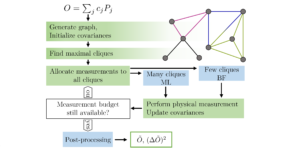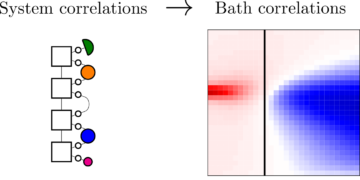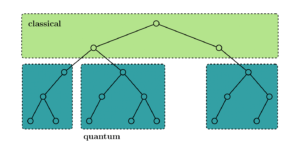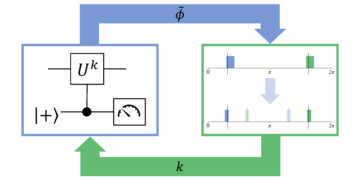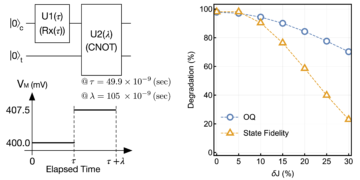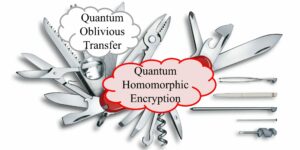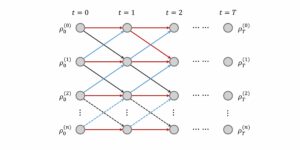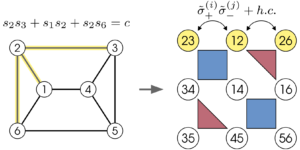Department of Physical and Environmental Sciences, University of Toronto Scarborough, Toronto, Ontario M1C 1A4, Canada
Chemical Physics Theory Group, Department of Chemistry, University of Toronto, Toronto, Ontario M5S 3H6, Canada
Find this paper interesting or want to discuss? Scite or leave a comment on SciRate.
Abstract
Solving the electronic structure problem via unitary evolution of the electronic Hamiltonian is one of the promising applications of digital quantum computers. One of the practical strategies to implement the unitary evolution is via Trotterization, where a sequence of short-time evolutions of fast-forwardable (i.e. efficiently diagonalizable) Hamiltonian fragments is used. Given multiple choices of possible Hamiltonian decompositions to fast-forwardable fragments, the accuracy of the Hamiltonian evolution depends on the choice of the fragments. We assess efficiency of multiple Hamiltonian partitioning techniques using fermionic and qubit algebras for the Trotterization. Use of symmetries of the electronic Hamiltonian and its fragments significantly reduces the Trotter error. This reduction makes fermionic-based partitioning Trotter errors lower compared to those in qubit-based techniques. However, from the simulation-cost standpoint, fermionic methods tend to introduce quantum circuits with a greater number of T-gates at each Trotter step and thus are more computationally expensive compared to their qubit counterparts.
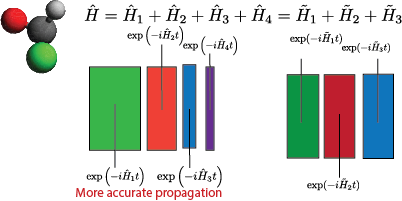
[embedded content]
Popular summary
One popular strategy to implement time propagation consists on dividing-up the simulated Hamiltonian in a sum of easy-to-diagonalize sub-Hamiltonians such that each of the latter can be translated into quantum-computer circuitry. Then, time propagation can be approximated as a sequential application of time-propagators generated by each of these sub-Hamiltonians, in the so-called Trotter approximation.
The decomposition of molecular Hamiltonians into easy-to-simulate sub-Hamiltonians is not unique, and in fact there exists a myriad of methods that carry out this task. The accuracy of the ensuing Trotter-approximated time-propagator is dependent of the chosen method. In this work, we perform an analysis of several Hamiltonian decomposition methods and get insight on the ideal traits of the individual Hamiltonian fragments that increase the accuracy of time propagation, as well as the cost of their corresponding implementation. Understanding of these characteristics is central for the design of Hamiltonian decomposition methods that aid more accurate time propagation implementations with an optimal balance in their concomitant cost in quantum computers.
► BibTeX data
► References
[1] Trygve Helgaker, Poul Jorgensen, and Jeppe Olsen. “Molecular electronic-structure theory”. John Wiley & Sons. (2014).
https://doi.org/10.1002/9781119019572
[2] Andrew M. Childs, Richard Cleve, Enrico Deotto, Edward Farhi, Sam Gutmann, and Daniel A. Spielman. “Exponential algorithmic speedup by a quantum walk”. In Proceedings of the Thirty-Fifth Annual ACM Symposium on Theory of Computing. Pages 59–68. New York, NY, USA (2003).
https://doi.org/10.1145/780542.780552
[3] Andrew M Childs. “On the relationship between continuous-and discrete-time quantum walk”. Commun. Math. Phys. 294, 581–603 (2010).
https://doi.org/10.1007/s00220-009-0930-1
[4] Guang Hao Low and Isaac L. Chuang. “Hamiltonian simulation by qubitization”. Quantum 3, 163 (2019).
https://doi.org/10.22331/q-2019-07-12-163
[5] Andrew M. Childs and Nathan Wiebe. “Hamiltonian simulation using linear combinations of unitary operations”. Quantum Inf. Comput. 12, 901–924 (2012).
https://doi.org/10.26421/QIC12.11-12-1
[6] Seth Lloyd. “Universal quantum simulators”. Science 273, 1073–1078 (1996).
https://doi.org/10.1126/science.273.5278.1073
[7] Andrew M. Childs and Yuan Su. “Nearly optimal lattice simulation by product formulas”. Phys. Rev. Lett. 123, 050503 (2019).
https://doi.org/10.1103/PhysRevLett.123.050503
[8] Ryan Babbush, Jarrod McClean, Dave Wecker, Alán Aspuru-Guzik, and Nathan Wiebe. “Chemical basis of trotter-suzuki errors in quantum chemistry simulation”. Physical Review A 91, 022311 (2015).
https://doi.org/10.1103/PhysRevA.91.022311
[9] Ian D. Kivlichan, Craig Gidney, Dominic W. Berry, Nathan Wiebe, Jarrod McClean, Wei Sun, Zhang Jiang, Nicholas Rubin, Austin Fowler, Alán Aspuru-Guzik, Hartmut Neven, and Ryan Babbush. “Improved fault-tolerant quantum simulation of condensed-phase correlated electrons via trotterization”. Quantum 4, 296 (2020).
https://doi.org/10.22331/q-2020-07-16-296
[10] Minh C. Tran, Su-Kuan Chu, Yuan Su, Andrew M. Childs, and Alexey V. Gorshkov. “Destructive error interference in product-formula lattice simulation”. Phys. Rev. Lett. 124, 220502 (2020).
https://doi.org/10.1103/PhysRevLett.124.220502
[11] Andrew M. Childs, Yuan Su, Minh C. Tran, Nathan Wiebe, and Shuchen Zhu. “Theory of trotter error with commutator scaling”. Phys. Rev. X 11, 011020 (2021).
https://doi.org/10.1103/PhysRevX.11.011020
[12] Conor Mc Keever and Michael Lubasch. “Classically optimized hamiltonian simulation”. Phys. rev. res. 5, 023146 (2023).
https://doi.org/10.1103/PhysRevResearch.5.023146
[13] Abhinav Kandala, Antonio Mezzacapo, Kristan Temme, Maika Takita, Markus Brink, Jerry M. Chow, and Jay M. Gambetta. “Hardware-efficient variational quantum eigensolver for small molecules and quantum magnets”. Nature 549, 242–246 (2017).
https://doi.org/10.1038/nature23879
[14] Yuta Matsuzawa and Yuki Kurashige. “Jastrow-type decomposition in quantum chemistry for low-depth quantum circuits”. J. Chem. Theory Comput. 16, 944–952 (2020).
https://doi.org/10.1021/acs.jctc.9b00963
[15] Vladyslav Verteletskyi, Tzu-Ching Yen, and Artur F. Izmaylov. “Measurement optimization in the variational quantum eigensolver using a minimum clique cover”. J. Chem. Phys. 152, 124114 (2020).
https://doi.org/10.1063/1.5141458
[16] Tzu-Ching Yen, Vladyslav Verteletskyi, and Artur F. Izmaylov. “Measuring all compatible operators in one series of single-qubit measurements using unitary transformations”. J. Chem. Theory Comput. 16, 2400–2409 (2020).
https://doi.org/10.1021/acs.jctc.0c00008
[17] Mario Motta, Erika Ye, Jarrod R. McClean, Zhendong Li, Austin J. Minnich, Ryan Babbush, and Garnet Kin-Lic Chan. “Low rank representations for quantum simulation of electronic structure”. NPJ Quantum Inf. 7, 1–7 (2021).
https://doi.org/10.1038/s41534-021-00416-z
[18] Tzu-Ching Yen and Artur F. Izmaylov. “Cartan subalgebra approach to efficient measurements of quantum observables”. PRX Quantum 2, 040320 (2021).
https://doi.org/10.1103/PRXQuantum.2.040320
[19] Alberto Peruzzo, Jarrod McClean, Peter Shadbolt, Man-Hong Yung, Xiao-Qi Zhou, Peter J. Love, Alán Aspuru-Guzik, and Jeremy L. O’Brien. “A variational eigenvalue solver on a photonic quantum processor”. Nat. Commun. 5, 1–7 (2014).
https://doi.org/10.1038/ncomms5213
[20] Ewout van den Berg and Kristan Temme. “Circuit optimization of hamiltonian simulation by simultaneous diagonalization of pauli clusters”. Quantum 4, 322 (2020).
https://doi.org/10.22331/q-2020-09-12-322
[21] Michael A. Nielsen and Isaac L. Chuang. “Quantum computation and quantum information”. Cambridge University Press. (2010).
https://doi.org/10.1017/CBO9780511976667
[22] Craig Gidney and Austin G Fowler. “Efficient magic state factories with a catalyzed $| ccz rangle $ to $2| trangle $ transformation”. Quantum 3, 135 (2019).
https://doi.org/10.22331/q-2019-04-30-135
[23] Masuo Suzuki. “General theory of fractal path integrals with applications to many-body theories and statistical physics”. J. Math. Phys. 32, 400–407 (1991).
https://doi.org/10.1063/1.529425
[24] Ignacio Loaiza, Alireza Marefat Khah, Nathan Wiebe, and Artur F Izmaylov. “Reducing molecular electronic hamiltonian simulation cost for linear combination of unitaries approaches”. Quantum Sci. Technol. 8, 035019 (2023).
https://doi.org/10.1088/2058-9565/acd577
[25] David Layden. “First-order trotter error from a second-order perspective”. Phys. Rev. Lett. 128, 210501 (2022).
https://doi.org/10.1103/PhysRevLett.128.210501
[26] Vlad Gheorghiu, Michele Mosca, and Priyanka Mukhopadhyay. “A (quasi-) polynomial time heuristic algorithm for synthesizing t-depth optimal circuits”. Npj Quantum Inf. 8, 1–11 (2022).
https://doi.org/10.1038/s41534-022-00624-1
[27] Priyanka Mukhopadhyay, Nathan Wiebe, and Hong Tao Zhang. “Synthesizing efficient circuits for hamiltonian simulation”. npj Quantum Information 9, 31 (2023).
https://doi.org/10.1038/s41534-023-00697-6
[28] Jacob T Seeley, Martin J Richard, and Peter J Love. “The bravyi-kitaev transformation for quantum computation of electronic structure”. J. Chem. Phys. 137, 224109 (2012).
https://doi.org/10.1063/1.4768229
[29] Artur F Izmaylov and Tzu-Ching Yen. “How to define quantum mean-field solvable hamiltonians using lie algebras”. Quantum Science and Technology 6, 044006 (2021).
https://doi.org/10.1088/2058-9565/ac1040
[30] Seonghoon Choi, Ignacio Loaiza, and Artur F Izmaylov. “Fluid fermionic fragments for optimizing quantum measurements of electronic hamiltonians in the variational quantum eigensolver”. Quantum 7, 889 (2023).
https://doi.org/10.22331/q-2023-01-03-889
[31] Joonho Lee, Dominic W Berry, Craig Gidney, William J Huggins, Jarrod R McClean, Nathan Wiebe, and Ryan Babbush. “Even more efficient quantum computations of chemistry through tensor hypercontraction”. PRX Quantum 2, 030305 (2021).
https://doi.org/10.1103/PRXQuantum.2.030305
[32] P. Jordan and E. Wigner. “Über das paulische Äquivalenzverbot.”. Z. Physik 47, 631–651 (1928).
https://doi.org/10.1007/BF01331938
[33] Sergey B. Bravyi and Alexei Yu Kitaev. “Fermionic quantum computation”. Ann. Phys. 298, 210–226 (2002).
https://doi.org/10.1006/aphy.2002.6254
[34] Zachary Pierce Bansingh, Tzu-Ching Yen, Peter D Johnson, and Artur F Izmaylov. “Fidelity overhead for nonlocal measurements in variational quantum algorithms”. J. Phys. Chem. A 126, 7007–7012 (2022).
https://doi.org/10.1021/acs.jpca.2c04726
[35] Ophelia Crawford, Barnaby van Straaten, Daochen Wang, Thomas Parks, Earl Campbell, and Stephen Brierley. “Efficient quantum measurement of pauli operators in the presence of finite sampling error”. Quantum 5, 385 (2021).
https://doi.org/10.22331/q-2021-01-20-385
[36] Yuan Su, Hsin-Yuan Huang, and Earl T. Campbell. “Nearly tight trotterization of interacting electrons”. Quantum 5, 495 (2021).
https://doi.org/10.22331/q-2021-07-05-495
[37] S. Bravyi, J.M. Gambetta, A. Mezzacapo, and K Temme. “Tapering off qubits to simulate fermionic hamiltonians.” (2017). arXiv:1701.08213.
arXiv:1701.08213
[38] Jarrod R. McClean, Nicholas C. Rubin, Kevin J. Sung, Ian D. Kivlichan, Xavier Bonet-Monroig, Yudong Cao, Chengyu Dai, E. Schuyler Fried, Craig Gidney, Brendan Gimby, et al. “Openfermion: the electronic structure package for quantum computers”. Quantum Sci. Technol. 5, 034014 (2020).
https://doi.org/10.1088/2058-9565/ab8ebc
[39] Dominic W. Berry, Brendon L. Higgins, Stephen D. Bartlett, Morgan W. Mitchell, Geoff J. Pryde, and Howard M. Wiseman. “How to perform the most accurate possible phase measurements”. Phys. Rev. A 80, 052114 (2009).
https://doi.org/10.1103/PhysRevA.80.052114
[40] Markus Reiher, Nathan Wiebe, Krysta M. Svore, Dave Wecker, and Matthias Troyer. “Elucidating reaction mechanisms on quantum computers”. Proc. Natl. Acad. Sci. U.S.A. 114, 7555–7560 (2017).
https://doi.org/10.1073/pnas.1619152114
[41] Jakob S Kottmann, Sumner Alperin-Lea, Teresa Tamayo-Mendoza, Alba Cervera-Lierta, Cyrille Lavigne, Tzu-Ching Yen, Vladyslav Verteletskyi, Philipp Schleich, Abhinav Anand, Matthias Degroote, et al. “Tequila: A platform for rapid development of quantum algorithms”. Quantum Sci. Technol. 6, 024009 (2021).
https://doi.org/10.1088/2058-9565/abe567
[42] Pauli Virtanen, Ralf Gommers, Travis E. Oliphant, Matt Haberland, Tyler Reddy, David Cournapeau, Evgeni Burovski, Pearu Peterson, Warren Weckesser, Jonathan Bright, Stéfan J. van der Walt, Matthew Brett, Joshua Wilson, K. Jarrod Millman, Nikolay Mayorov, Andrew R. J. Nelson, Eric Jones, Robert Kern, Eric Larson, C J Carey, İlhan Polat, Yu Feng, Eric W. Moore, Jake VanderPlas, Denis Laxalde, Josef Perktold, Robert Cimrman, Ian Henriksen, E. A. Quintero, Charles R. Harris, Anne M. Archibald, Antônio H. Ribeiro, Fabian Pedregosa, Paul van Mulbregt, and SciPy 1.0 Contributors. “SciPy 1.0: Fundamental Algorithms for Scientific Computing in Python”. Nat. Methods 17, 261–272 (2020).
https://doi.org/10.1038/s41592-019-0686-2
[43] Roger Fletcher. “Practical methods of optimization”. John Wiley & Sons. (2013).
https://doi.org/10.1002/9781118723203
Cited by
[1] Guang Hao Low, Yuan Su, Yu Tong, and Minh C. Tran, “On the complexity of implementing Trotter steps”, arXiv:2211.09133, (2022).
[2] Guang Hao Low, Yuan Su, Yu Tong, and Minh C. Tran, “Complexity of Implementing Trotter Steps”, PRX Quantum 4 2, 020323 (2023).
[3] Seonghoon Choi, Ignacio Loaiza, and Artur F. Izmaylov, “Fluid fermionic fragments for optimizing quantum measurements of electronic Hamiltonians in the variational quantum eigensolver”, Quantum 7, 889 (2023).
[4] Smik Patel, Tzu-Ching Yen, and Artur F. Izmaylov, “Extension of exactly-solvable Hamiltonians using symmetries of Lie algebras”, arXiv:2305.18251, (2023).
[5] Oriel Kiss, Michele Grossi, and Alessandro Roggero, “Importance sampling for stochastic quantum simulations”, Quantum 7, 977 (2023).
The above citations are from SAO/NASA ADS (last updated successfully 2023-08-17 04:31:15). The list may be incomplete as not all publishers provide suitable and complete citation data.
On Crossref’s cited-by service no data on citing works was found (last attempt 2023-08-17 04:31:14).
This Paper is published in Quantum under the Creative Commons Attribution 4.0 International (CC BY 4.0) license. Copyright remains with the original copyright holders such as the authors or their institutions.
- SEO Powered Content & PR Distribution. Get Amplified Today.
- PlatoData.Network Vertical Generative Ai. Empower Yourself. Access Here.
- PlatoAiStream. Web3 Intelligence. Knowledge Amplified. Access Here.
- PlatoESG. Automotive / EVs, Carbon, CleanTech, Energy, Environment, Solar, Waste Management. Access Here.
- PlatoHealth. Biotech and Clinical Trials Intelligence. Access Here.
- ChartPrime. Elevate your Trading Game with ChartPrime. Access Here.
- BlockOffsets. Modernizing Environmental Offset Ownership. Access Here.
- Source: https://quantum-journal.org/papers/q-2023-08-16-1086/
- :is
- :not
- :where
- ][p
- 1
- 10
- 11
- 12
- 13
- 14
- 15%
- 16
- 17
- 19
- 1996
- 20
- 2012
- 2013
- 2014
- 2015
- 2017
- 2019
- 2020
- 2021
- 2022
- 2023
- 22
- 23
- 24
- 25
- 26%
- 27
- 28
- 30
- 31
- 32
- 33
- 36
- 385
- 39
- 40
- 7
- 8
- 80
- 9
- 91
- a
- above
- ABSTRACT
- access
- accomplished
- accuracy
- accurate
- ACM
- affiliations
- Aid
- AL
- algorithm
- algorithmic
- algorithms
- All
- an
- analysis
- and
- Andrew
- annual
- Application
- applications
- approach
- approaches
- approximately
- ARE
- AS
- assess
- assessment
- At
- Aug
- austin
- author
- authors
- Balance
- based
- basis
- BE
- between
- Break
- Bright
- brink
- by
- cambridge
- CAN
- carry
- central
- chan
- characteristics
- Charles
- chemistry
- choice
- choices
- chosen
- chow
- clique
- closely
- combination
- combinations
- comment
- Commons
- compared
- compatible
- complete
- complexity
- computation
- computations
- computer
- computers
- computing
- consists
- content
- contributors
- copyright
- Corresponding
- Cost
- cover
- Craig
- DAI
- Daniel
- data
- Dave
- David
- define
- Department
- dependent
- depends
- Design
- Development
- Devices
- digital
- discuss
- e
- E&T
- each
- Edward
- efficiency
- efficient
- efficiently
- Electronic
- electrons
- embedded
- energy
- environmental
- Erika
- error
- Errors
- evolution
- evolutions
- evolving
- exists
- expensive
- extension
- fact
- factories
- fluid
- For
- found
- from
- fundamental
- future
- generated
- get
- given
- greater
- Group
- harvard
- holders
- Hong
- However
- HTTPS
- huang
- i
- ideal
- implement
- implementation
- implementing
- importance
- in
- Increase
- individual
- information
- insight
- institutions
- interacting
- interesting
- Interference
- International
- into
- introduce
- ITS
- JavaScript
- John
- Johnson
- jonathan
- jones
- Jordan
- journal
- kiss
- knowledge
- Last
- Leave
- Lee
- Li
- License
- lie
- List
- love
- Low
- lower
- magic
- Magnets
- MAKES
- mario
- Martin
- math
- matthew
- max-width
- May..
- mc
- mcclean
- measurement
- measurements
- mechanisms
- method
- methods
- Michael
- minimum
- molecular
- Month
- more
- more efficient
- Morgan
- most
- multiple
- myriad
- Nature
- New
- New York
- nicholas
- no
- number
- NY
- of
- off
- on
- ONE
- only
- Ontario
- open
- Operations
- operators
- optimal
- optimization
- optimized
- optimizing
- or
- original
- out
- package
- pages
- Paper
- path
- Paul
- Perform
- perspective
- Peter
- Peterson
- phase
- physical
- Physics
- pierce
- platform
- Platforms
- plato
- Plato Data Intelligence
- PlatoData
- Popular
- possible
- Practical
- presence
- press
- Problem
- PROC
- Proceedings
- Processor
- Product
- promising
- provide
- published
- publisher
- publishers
- Python
- Quantum
- quantum algorithms
- Quantum Computer
- quantum computers
- quantum information
- quantum measurement
- Qubit
- qubits
- R
- Ralf
- rank
- rapid
- reaction
- reduces
- reduction
- references
- related
- relationship
- remains
- review
- Richard
- ROBERT
- Ryan
- s
- Sam
- scales
- scaling
- SCI
- Science
- Science and Technology
- SCIENCES
- scientific
- Sequence
- Series
- several
- significantly
- simulation
- small
- standpoint
- State
- statistical
- Step
- Stephen
- Steps
- strategies
- Strategy
- structure
- Successfully
- such
- suitable
- Sun
- Symposium
- system
- Task
- techniques
- Technology
- that
- The
- The Future
- their
- then
- theory
- There.
- These
- this
- those
- Through
- Thus
- time
- Title
- to
- toronto
- Transformation
- transformations
- tyler
- under
- understanding
- unique
- university
- updated
- URL
- USA
- use
- used
- using
- various
- via
- vlad
- volume
- W
- want
- warren
- was
- we
- WELL
- william
- Wilson
- with
- Work
- works
- X
- Ye
- year
- Yen
- york
- youtube
- Yuan
- zephyrnet



